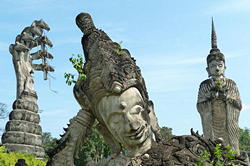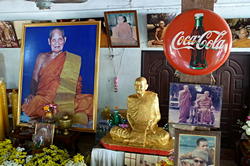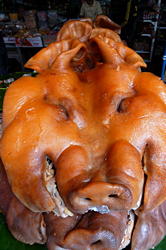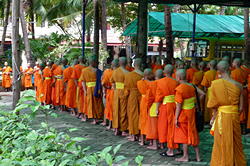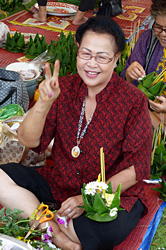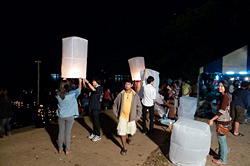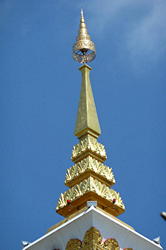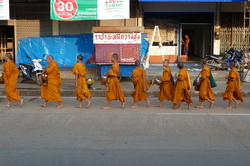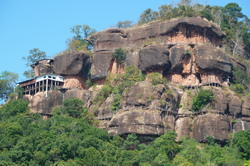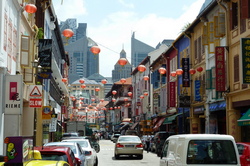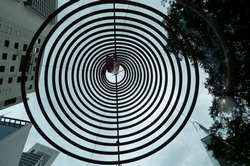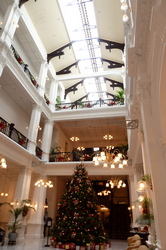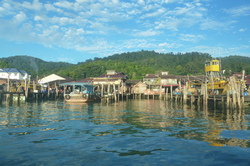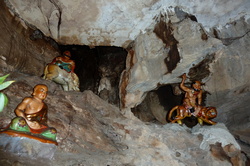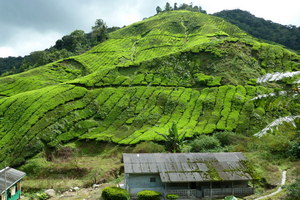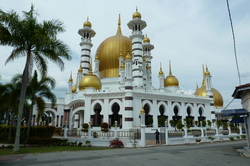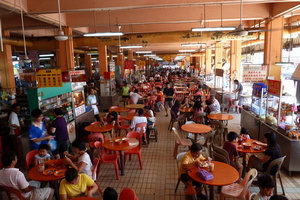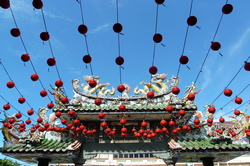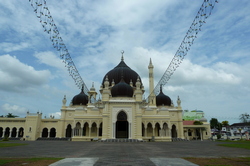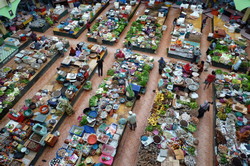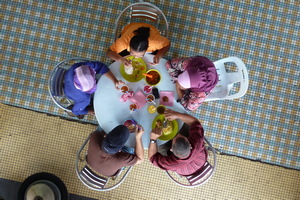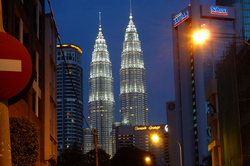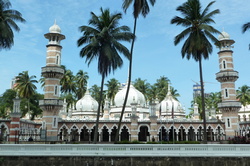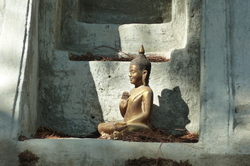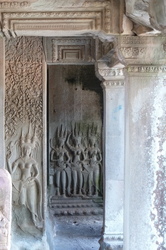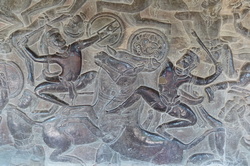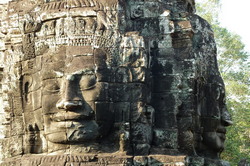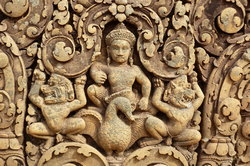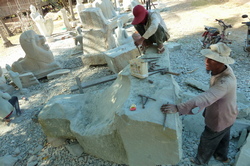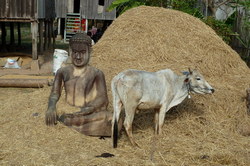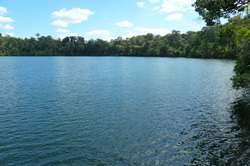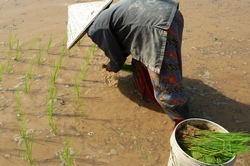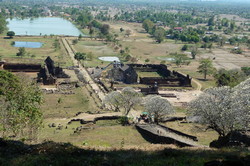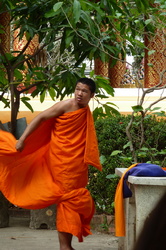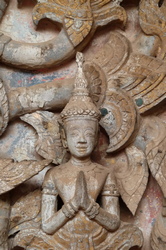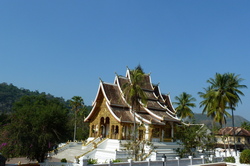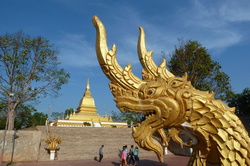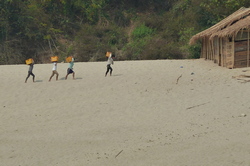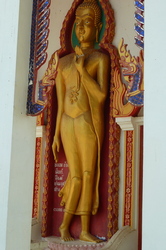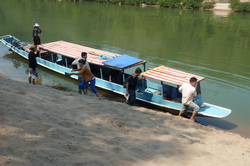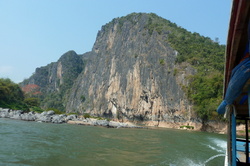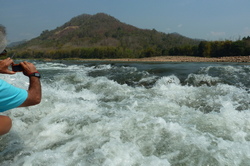Email Updates English
Following is the full text of all English email updates we sent during this trip. The texts are original copies, shown here as sent: typos, errors, warts and all (the same in French).
We've also included the pictures attached to the mails (or, in the case of the first two emails, put into a Google+ album). Clicking a thumbnail will open a bigger version and use the left and right cursor keys to navigate from one picture to the other.
- Mail from 20 Oct 2011: Off we go...
- Mail from 02 Nov 2011: We're gone...
- Mail from 09 Nov 2011: Nong Khai, Chiang Khan and Khon Kaen
- Mail from 16 Nov 2011: Khon Kaen, Mukdahan and upstream the Mekong
- Mail from 23 Nov 2011: Wat Phu Tok, Udon Thani and Bangkok
- Mail from 30 Nov 2011: Singapore, Malaysia
- Mail from 08 Dec 2011: Pulau Pangkor, Ipoh, Cameron Highlands
- Mail from 15 Dec 2011: Kuala Kangsar, Taiping, Penang
- Mail from 22 Dec 2011: Teluk Bahang (Penang Island), Alor Star, Kota Bahru
- Mail from 30 Dec 2011: Kuala Lumpur, Phnom Penh
- Mail from 08 Jan 2012: Battambang, Siem Reap, Angkor Wat
- Mail from 16 Jan 2012: Kompong Thom, Kompong Cham
- Mail from 23 Jan 2012: Northeast Cambodia
- Mail from 29 Jan 2012: Laos -- the south, Vientiane
- Mail from 06 Feb 2012: Vientiane, Vang Vieng, Luang Prabang
- Mail from 16 Feb 2012: Luang Prabang, Laos north
- Mail from 25 Feb 2012: Mekong, Chiang Rai, Sukhothai, Bangkok
- Mail from 09 Mar 2012: Calamyti 2011: conclusion (and some loose ends)
Subject: Off we go...
Date: Thu, 20 Oct 2011 11:32:19 +0100
Dear friends, after a long hiatus another mail from Vero and Thomas. As many of you already know, we took our house off the market in May: the price was a tad too low and the pound/euro exchange rate was (and still is) not really enticing (read: lousy). So for the time being we'll stay put in the UK and divide our time between this lovely Isle (around 4 months per year), the continent (another 4 months) and some long-distance travel (final 4 months). And our next trip is coming up fast. Its code name (we love code names) is "CaLaMyTi 11", that's short for CAmbodia, LAos, MalaYsia, ThaIland 2011. Originally we wanted to go to MYanmar (instead of MalaYsia) but for various reasons to do with crisp dollar notes, ungodly flight hours and the new (and completely rotten) Thai visa regime we've changed plans just a couple of weeks ago. More about that in a later mail. This mail is mostly a reminder that we're still alive;-) and also a check to make sure we still have all the right email addresses (if you plan to change addresses and don't notify us, our mails will bounce and we'll have to pull you off the list). Also, if anyone would rather be taken off the list anyway, just send us a short note. (We have around 150 people on the list and we're not sure how many recipients Google Mail does accept, so we always try to keep the list trim and neat.) We will again send regular email updates from the road, as we did in the past; this time, we'll even include links to photos we'll upload to Google+. (We may also send some short notes via Google+ but as we have not really used this gadget so far, that will be more a test/dummy run.) There should be another mail sometime next week with more details and some background. Till then, feel free to contact us with any questions you may have and have a look at our travel website (that's https://trvl2.com ). There's also a map, lovingly put together by Vero, with our planned itinerary and some further information (the Singapore/Malaysia bits are still a work in progress). The map can be found at https://trvl2.com/=cal11a . All the best Vero and Thomas
Subject: We're gone...
Date: Wed, 2 Nov 2011 08:28:52 +0000
Dear friends, as promised, here's another email installment before we leave: our flight to Bangkok is due to take off in a few hours' time, so this stuff is really hot off the presses;-) But first a word about the current flood situation in Bangkok: as usual, Western media vie with each other to paint the most dramatic picture, whatever the reality on the ground. While some outlying parts of Bangkok are indeed flooded (with all the hardships this entails for the victims) most of the city has remained bone dry. The international airport works, almost all the buses run according to schedule, the trains to the north have been restarted and despite dramatic footage from a "flooded Grand Palace" no local (or tourist) has yet drowned there. If you want the take of an expat who lives in Bkk (one of many we followed during last week), check this: https://www.gregtodiffer.com/a-flood-of-information-in-a-dry-city . This sentiment is echoed by many others. And now a few remarks about our itinerary. We'll be staying in SE Asia for exactly four months. The first leg of the trip will take us for three weeks through northeastern Thailand, a region called Isaan. This part of the country is rarely visited by tourists and is completely new to us. Highlights include a long stretch of the mighty Mekong, a couple of famous temples and pilgrimage sites and the relaxed cities and towns for which the reason is known among Thais. While we're there, the great festival of Loi (or Loy) Krathong (see https://en.wikipedia.org/wiki/Loi_Krathong ) will take place; we'll probably be in a city called Khon Kaen for that. After three weeks we'll head back to Bangkok, to catch a flight to Singapore. First time for us, so this will be a definite highlight to look forward to. After a few days (4, 5 or 6?) there we'll head over the border to Malaysia. Again, we've not seen this country before, so more new impressions and vistas await. We very much like the idea to once gain visit a Muslim country (we haven't managed to see the Middle East for ages) and we're especially keen to find out how Malaysia feels in a sea of non-Muslim countries. We'll spend around four weeks there and then will fly from Kuala Lumpur to Phnom Penh in Cambodia. (All this flying around has to do with the Thai visa regime which is an abomination: while we understand that the Thai authorities have to crack down on the zillion semi-residents their visa restrictions have now reached a level where they seriously interfere with people on an overland trip around the region. For instance, to be allowed into the country you MUST produce a ticket for onward air transportation within 30 days of entering the country. That means that an overland trip starting in Bangkok with a duration of more than 30 days is simply impossible now.) Cambodia, of course, is relatively well-trodden ground for us: we've been there already twice and we really enjoyed the friendliness and hospitality of the Cambodians. We very much look forward to seeing the absolutely fabulous ruins of Angkor Wat again. But we will also explore the rather remote regions in the north (for instance the Prasat Preah Vihear temple, see https://en.wikipedia.org/wiki/Prasat_Preah_Vihear ) on the Thai/Cambodia border) and the northeast. After another 30 days, from Stung Treng in the far northeast we plan to hop over to Si Phan Don in the sleepy, laid-back far south of Laos. Those who've already followed us for a while will remember that we were not very taken by Laos during our first stay in 2007; that's precicely why we're going back again. This time, we come with much lower expectations (back then everyone and his dog told us that Laos is THE greatest place on earth whereas we found the Laotians much to apathetic and laid-back for our liking). This time, we'll concentrate on the northern half of the country -- the south is definitely too sleepy for us;-) Well, a few more days in Thailand and there you have it: CaLaMyTi 2011. The first "real" update should come within about a week, from somewhere in northeastern Thailand (BTW, the weather forecast says sunny, 32C;-). Till then you might want to have a look at the map Vero has produced (see https://trvl2.com/=cal11a ). There's also some background on how Vero did the budgeting for this trip including some graphics and hard numbers, please see https://trvl2.com/Calamyti11 . Will be interesting to see how this forecast compares to the final bill... Vero loves to do these things and will prepare a summary, once we're back. All the best Vero + Thomas
Subject: Nong Khai, Chiang Khan and Khon Kaen
Date: Wed, 9 Nov 2011 15:50:51 +0700
Dear friends, we are now in Khon Kaen, in the centre of the Isaan region. So far everything went smoothly. Upon arriving in Bangkok we saw that huge parts of the northern suburbs are indeed under water, though other, neighbouring strips equally big are completely dry. It' not clear why some areas are flooded while others remain bone dry. There's is in any case a palpable sense of crisis in the air though much of this seems to stem from swirling rumours and misinformation which in turn have to do with the fact that the various official agencies (government, Bkk city council etc) tend to give conflicting information. Also people have come to expect the worst, even the impossible! Anyway, we hopped onto a night bus from the airport directly to Nong Khai, around 650km to the northeast. The first day there wasn't great as we had travelled for 40 hours without real sleep but somehow we managed. The good thing about these "gruelling" journeys is that you're so totally tired that the body forgets all about timezones and does a complete reset! (Re the 40 hours: a lot of that time was spent with perfecting the art of waiting. We spent a total of 13 hours in the air and 10 on the night bus. The rest was waiting in Heathrow, Amman and Bkk airport.) Nong Khai is on the Thai/Lao border and on the banks of the majestic Mekong which is about a kilometre wide here (and red from the topsoil washed away from the Lao side where there's lots of deforestation). Nong Khai is an up-and-coming town as there's a bridge over the river to Vientiane... many falang (Thai for foreigners). However, there are also many, many Thai tourists and we think that this time, we will see a lot more Thais doing the rounds than we did four years ago. We visited many Wats (temples) including one with a famous Buddha statue (with a head made of pure gold!) which was stolen in the 15th century from the Lao side. There's also a well-known "sculpture" park, the sculptures being giant concrete figures of Buddhas and Hindu divinities and other interesting Thai characters. The biggest of these is 25m high: a Buddha crowned by seven naga (river snakes). We wanted to invclude a picture but somehow the PC we're sitting on doesn't accept our camera. Will follow! We spent four days in Nong Khai and then drove along the river road upstream to a place called Chiang Khan. This was supposed to be a sleepy backwater according to the guide books but it turned out to be in the midst of transforming itself into the very definition of a tourist trap: it reminded us of Hoi An in Vietnam which was filled with shops, hotels, tailors, cafes, restaurants, more shops, souvenir outlets... Chiang Khan is getting there. And the reason? An influx of Thai tourists who are all set to visit the "gorgeous" (not our words, Lonely Planet's) rapids 5km downstream. We walked there (to the amazement of the Thais) and well, it's a few rocks in the water and a really tiny rapid. This was definitely the anti-climax of the week! Along the way, we ran into a school teacher who invited us to his school where we practiced English with the girls for a good while (they in return fed us with tea and coconut juice). The one thing that amazed us was that most of the school girls (who were very shy) looked like 13, perhaps 14 -- but were in fact over 18! This was a real eye-opener and gives some perspective to the roaring sex trade in Thailand (of which we know very little): someone so inclined can have legal sex with a woman that looks for all intents and purposes like a timid school girl, perhaps WAS a timid school girl just a few months before. This encounter (and the famously open and outgoing Thai society) did explain a lot about why Thailand has become such a mecca for some people. Back to the river: the drive along the Mekong and the landscape (wooded hills, even almost mountains at times) was worth the detour. All the more as this part of Thailand is still very rural and you can see scenes that remind you more of Nepal than the supposedly "high-tech" Thailand. All very enjoyable. Today, we drove across more beautiful, rocky landscapes from CK to Khon Kaen, the biggest town in the Isaan region. This is a complete contrast to CK and the Mekong villages: hustle, bustle, congestion and a very lively crowd of Thais. Foreigners are a rarity here (as almost everywhere in the Isaan). This variety is indeed one of the joys of travelling backpacking-style in Thailand! The weather has been good so far: very warm and humid, and mostly sunny. We had one day with just a little rain and it rained heavily last night. The forecast is good. Foodwise, we have done what we most enjoy: going to the night markets. These are congregations of open-air kitchens with all sorts of food: noodles, fried or in soup; rice; curries; fish big and small; mussels and shrimps; delicious eggs concoctions and of course various sweet things. We tend to have a noodle soup with beef or pork, some rice (sticky rice, like in Lao is common here) some fried noodles or an egg/shrimp omelet. Well, that's it for the time being, more will follow in about 8-10 days' time, probably from a place called Udon Thani, a bit north of Khon Kaen. We'll get there by another epic round along the banks of the Mekong. More will follow! All the best Vero + Thomas PS: The Thais can't pronounce "Vero", they instead say something like "Veho" or "Ve'o". Funny.
Click on a picture to view the whole gallery of pictures attached to the mails and use the left and right arrows cursor keys to navigate from one picture to the other
Subject: Khon Kaen, Mukdahan and upstream the Mekong
Date: Wed, 16 Nov 2011 15:38:43 +0700
Dear friends, we've just arrived in a sleepy backwater called Bung (or Beung) Kan, on the Mekong. This place must be the sleepiest village this side of the Mekong... in fact, this northeastern most bit of Thailand feels quite Laotian... all that happens (not a lot) happens very, very, very sloooowly. Tomorrow we'll head to Wat Phu Tok, a daytrip to an even more backwaterish place where there is a famous meditation wat on top of a big rock (including some climbing... perhaps to Nirvana?). Back to Khon Kaen, where we left you. This is the biggest city in the Isaan region and in all probability also the ugliest: concrete and dust everywhere. The exception is the lake in the southeast which is surrounded by... you guessed it, many wats. The most famous of these is Wat Nong Wang, whose most important feature is a huge nine-tiered pagoda, supposedly a replica of the famous Shwedagon pagoda in Rangon in Myanmar. The views from there would be great if Khon Kaen were a nicer place that it is. It was at this lake that we observed the Thais during the Loy Krathong festival. This festival is designed to mollify the water spirits and also to get rid of the sins and bad deeds of the last year. To this effect, the Thais build (or these days, rather buy) a small floating vessel (called a Krathong) with flowers, incense and a few burning candles on it which they release on the next available body of water shortly after dark (that's where the lake comes in). It was a very pretty and also moving sight, all the more so as most Thai families also buy a sort of Chinese lantern which is sent up into the dark night. A multitude of these, with the full moon as a backdrop, plus the floating Krathongs make for a magnificent scene. Next day we took the bus to Mukdahan, a relatively big and lively town on the Mekong. There's nothing really amazing about this place, it's just a normal Thai town watching across the river to the Laotian town of Savannakhet (which we had visited already in 2006/7). There are, of course, many wats, some with nice features, but we'll spare you the details (there are as many wats in a Thai place as there are coffee shops in modern Western town centers). There's also a big Talat Indojina (Indochina market) there, but sadly almost all the shops sell the same cheap stuff from China with the same overpriced tag. One thing we had already noticed in Khon Kaen was that in this part of Thailand there are simply no tourists around. There are quite a few expats (always men) with their Thai wives but other than that no falang. Next stop was That Phanom, a small Mekong village with a big That: that's a sort of stupa, ie a tower with a Buddha relic, most often a bone, sometimes a hair, hidden inside (given the huge number of these relics in the various Buddhist countries, one could probably re-assemble a dozen Buddhas). The That in That Phanom (see https://en.wikipedia.org/wiki/Wat_Phra_That_Phanom ) is very holy and we spent quite an interesting afternoon there, wat-ching the comings and goings, the ceremonies and also visiting the many temples. It was in That Phanom that we ordered the worst noodle soup we ever had the misfortune to slurp in Thailand: the night market there is rather small and mostly geared towards people buying food to eat at home, not at people eating something on the spot. So there was no great choice and we had to sit down at the only noodle soup seller around. The soup looked not too bad but there were some undefined and disgusting bits of fish and pork internals (certainly not something eatable like liver;-) which made it taste like something already eaten... twice. But this has been really the exception: the food from the night markets is really superb, tasty and normally there's loads of choice. There's a Laotian market in That Phanom, where the Laotians come over in boats in droves to sell their wares. The most interesting of these are animal horns and teeth, bird claws, bones, and many different sorts of woods, roots and herbs. The Thais buy all that either for good luck or as a medicine or as natural Viagra. After That Phanom, we went to Nakhon Phanom, another nice town on the Mekong. Again, like Mukdahan, there's not a great deal to see, though the wats are nicer than in Mukdahan. We spent a relaxing day there and admired the views of the Laotian side, where rows of strangely formed mountains line the far river bank. A few photos are here: https://picasaweb.google.com/100855975620162154099/November162011?authuser=0&authkey=Gv1sRgCPzHs5-N8rzVygE&feat=directlink 1. Monks in Wat Nong Wang (Khon Kaen) during a ceremony 2. A Thai lady preparing a Krathong to sell later 3. Letting go the Chinese lanterns 4. The top level of That Phanom is made of pure gold: 16kg of it. Well, that's it for now, more will come probably from Bangkok in about a weeks' time. All the best Thomas + Ve'o PS: a few photos re the stuff we wrote about in our last mail -- click here: https://picasaweb.google.com/100855975620162154099/November92011?authuser=0&authkey=Gv1sRgCOaN9rPejv-nTg&feat=directlink BTW, we also found out why we couldn't read our camera card: many Thai Internet cafes disallow USB or card reader access for security reasons (ie in fear of catching a virus, trojan etc.)
Subject: Wat Phu Tok, Udon Thani and Bangkok
Date: Wed, 23 Nov 2011 10:47:39 +0700
Dear all, we are now in Bangkok, awaiting our flight to Singapore tomorrow. Here in inner Bangkok, it is and was dry (there are still many, many sandbags around... just in case!), but the northern districts still have enormous problems, though the floods are now slowly receding. On the way back from Udon Thani (night bus, 9 hours) we saw huge swathes still under water. Back to Bung Kan, where we had the day trip to Wat Phu Tok on the agenda. This wat is not a town wat (ie a wat for the general populace to go and pray and being parted from their money); rather, it is a meditation retreat for monks and so it's hidden deep in the Thai countryside. Many wats which serve as meditation wats are isolated, most often in woods and these are then called forest wats. Getting there involves catching a very early bus in Bung Kan (that's when we saw some monks doing their morning alms rounds, see attached photo) and then continuing with a tuk-tuk or a songthaew (literally "two rows", a sort of pickup with two rows of seats, left and right, in the back. However, Wat Phu Tok is not in a forest. It is situated on a high sandstone outcrop (see attached picture) and occupies 7 levels: the first three are not visible in the pic, the 4th to 6th can be made out as walkways around the whole rock and the 7th is the "summit" plateau. The three walkways contour the outcrop at their respective heights and they are sometimes pretty vertiginous. The lower two walks are lined with the bare, wooden cells of the monks (around 50) and nuns while on the 6th level there is a small cavern with the principal Buddha image (located on the left side). There are steep staircases connecting the various levels and also a set of long staircases leading up to level 4. The wat is really something to see and to experience: it is definitely one of the more strange wats we have seen so far. Next day we took a very sloooow bus from Bung Kan to Udon Thani (the buses really have a Laotian feel here; in fact most of the northeast feels a little like Laos, culturally and also foodwise). Udon is another rather big city in the Isaan region but (contrary to what the guide books implied) we found it rather enjoyable and a lot nicer than the concrete monstrosity that is Khon Kaen. For a start, there are three beautifully landscaped lakes with real green parks not the often-seen dried-up wasteland that passes for a park in these countries. There's not a lot to see and do in Udon other than a few temples and a museum (the night markets though are the best we've seen in the Isaan) but we had another longish daytrip planned: to a place called Phu Phrabat Historical Park. This is a hill 70km to the northwest of Udon with many eroded sandstone outcrops sporting all sorts of shapes. Some of the rocks are covered with "pre-historical" paintings (apparently 2-3000 years old): buffaloes, men in a row, handprints, abstract patterns. Not bad but somehow the place had the feeling of a made-up playground (though archeologists have checked that everything is kosher). A nice excursion into rural Thailand anyway. Now we're in hot and humid Bangkok where we do some of the main sites, like Wat Pho or the Golden Mount and Chinatown. As we have been here a few times before we know the place quite well, see the mails from Bangkok we wrote during our previous stays. Finally, a few random observations to round up the first Thai leg: * In the fields along the Mekong we saw many farmers and helpers (men and women). Most of them wear the distinctive Vietnamese conical hat: sometimes we imagined to be in Vietnam. (In fact, Vietnam is around the corner, so to speak: just cross the Mekong, catch a bus and 2 or 3 hours later, you're there.) * In the far northeast there are more water buffaloes on the roads than cars and the region is not very populated. * During our last visit we noted that almost all Thais wore a yellow plastic ribbon around their wrists with "Long live the King!" written on it. (The King is a highly revered figure here.) These days, almost nobody does. When we asked why, we received no real explanation... our hunch is that the Thais refrain from wearing this band in the moment because the King is very ill and might die any day... so it's perhaps not a very appropriate moment to wear such a band. * There are many rubber-tree plantations in the northeast and there are new ones opened all the time. * Football is big business here in Thailand: but the only league they're interested in is the English Premier League. Judging by the stickers, posters, car reg plates (really!) the most cherished club is Liverpool, followed by Chelsea. As for Man U... what is Man U? * The Thais couldn't function without plastic bags. We're not talking about the usual bags in the supermarket. Everything from soups to sweets to soft drinks is put into a perfectly-sized, clear plastic bag closed with a rubber tie. These bags come in a bewildering array of shapes and sizes, some long and thin, other almost square. Some are so small that you can only put in a tiny amount of liquid, these are used for chili sauce and other hot items. The next mail should arrive from somewhere in Malaysia, perhaps Melaka... inshallah! All the best Thomas + Vero
Subject: Singapore, Malaysia
Date: Wed, 30 Nov 2011 18:27:34 +0800
Dear friends, we are now in Malaysia, in Melaka (or Malacca, of the famous straits). We got from Bangkok to Singapore Changi airport in time (with Air Asia, not a bad budget airline). And unbelievably, we were in the MRT train to downtown within 25 minutes after touching down... immigration, baggage reclaim and money changing all done! This has been the fastest turnaround we've ever experienced... a good omen for our visit? Well, S'pore is (in)famous for its cleanliness (it IS clean: the city looks more like a western place than one of those grimy, smelly Asian metropolises); its tough laws (not as bad as we feared but pretty strict: there are many rules, regulations and "Verboten" signs). It is also hot, though cooler than Bangkok, and very humid... think sauna. There's a thunderstorm every afternoon with rain but not the rain we know in Europe: the rain here is not torrential, not even Torrential -- it's TORRENTIAL. But there are many covered walkways and shopping malls and other places to hide. The Singaporeans apparently do only two things: they shop until they drop and then they eat. After the meal they do some more shopping which in turn requires to have some more food... you get the idea. The number of shopping malls is unbelievable. The most famous shopping street is Orchard Rd and there are literally scores of malls, with all the usual retail names and many we've never even heard of. We think that on this street alone, there are more shops than in all of London's Oxford and Regent St AND in Paris' Champs Elysees and Rue de Rivoli together. And this is just one of many roads lined with shopping malls... There are also many restaurants and, even more importantly, "food centres", called hawker centres. The latter resemble Thai night markets as to choice and freshness of the food but they're all fixed stalls in a big, big hall and food sizzles everywhere. Amazing. The choice of food is also out of this world: Malay, Thai, all varieties of Chinese, Indian (north and south), Japanese... For those of you who've never been to S'pore, here's a sort of recipe of how to "cook up" the place, tongue in cheek: 1. Get healthy measures of Chinese, Indians and Malays, peppered with some pale Europeans. 2. Mix them thoroughly and let it stand for a while. 3. Get one part London City (with all those old buildings like the Bank of England), one part Portobello Road, one part South Bank (between Globe and Westminster Bridge, including London Eye) and finally three parts Canary Wharf. 4. Add loads of supersizing powder. 5. Put that and the mixture from part 1 into a blender, add heaps of money, heat and humidity... and presto! there you have it: Singapore. Singapore feels very British. Here's a short list of things that we thought stand out: 1. You need a big umbrella. Definitely. (Vero actually won one on day two... we'll tell the story later.) 2. The Singaporeans drive on the right, ie left, side. 3. They have the same mains sockets as in Britain, including the on/off switch. 4. The number plates on cars look like the old black/silver British plates. 5. They have London-style doubledecker buses. 6. There are single and double yellow lines on the road sides to regulate stopping and parking. 7. In the MRT (that's the S'pore version of the tube), they tell you to mind the gap, though they add a "Please" and so sound less imperative than the British "Mind the gap!" As to the actual sights. There's not a lot, to be honest. Chinatown (see attached photo) is so gentrified these days that it looks more like caricature of itself. It's not a tourist trap though because the locals stroll around its restaurants, shops and temples like we tourists do. Little India is slightly more authentic, but anyone who's ever been to India would barely recognise this as Indian. It's more a Disneyesque version of India than the real thing. The food there is authentic though. Of course, the British left the usual monuments, official buildings, cemeteries, churches (some of the latter are converted to... you guessed it: shopping malls), mostly along or near the banks of Singapore river. There also many pockets with nice old shophouses or residential houses (old here meaning anything older than 40 or 50 years). There's a surprising amount of greenery. Our last day in S'pore we spent on the so-called Southern Ridges, a walk in a few connected parks along a line of hills and in the Botanic Gardens. Both very worthwhile excursions though also very hot and sweaty. There are also many temples, Buddhist (totally different in style to a wat in Thailand), Chinese (see the attached photo where a big coil of incense burns away among the highrises), and Indian (mostly in the southern Indian, ie Tamil, style). We dutifully went to most of these, which was not as tiring as we expected: central S'pore is a surprisingly small area and easily explored on foot. This brings us to the one thing that really got on our nerves: S'pore is emphatically NOT a place for pedestrians. There are many people walking but the red lights phases for pedestrians are so incredibly long and the greens so short that you spend a lot of time waiting (in this respect the Singaporeans are like the Germans: pedestrians wait if the lights are red) while the traffic (fast, bordering on the aggressive) speeds along. To make matters worse, there are many building sites which require lengthy detours. Add the downpours when the streets are sometimes ankle-deep flooded and the speeding cars produce impressive water fountains... and you can see that walking in S'pore is not a pure joy. Never mind, we enjoyed the place even if it blew a big hole into our budget: one dorm bed (we stayed in dormitories for the whole time as hotels (like the Raffles, see attached photo) are just too expensive) is about four times more expensive than a budget double room in a Thailand hotel! Food and public transport is also more expensive but there we're talking about 50% or so, that's bearable. The trip from Singapore went without a hitch and so far, the differences between Singapore and Malaysia are not huge: similar weather (hot and humid, though there's less rain here), many shopping malls and foodstalls. The Malaysians seem to think as eating as a slightly less important pastime than the Singaporeans, though. The country seems to be rather modern, but it's definitely more "Asian" than S'pore, if you know what we mean... Melaka is a world heritage site, but in all honesty it only shows in the number of tourists and the amount of restaurants and museums (in fact, there are 30+ museums in town, many designed with local tourists in mind). The sea is nowadays far from the city: there are many highrises, streets etc between the town and beach. We went there nevertheless, to watch the traffic through the Straits: a few huge ships but not as many as we expected. The town itself has a few remains from the Portuguese (city walls and a gate), Dutch (Stadthuys and a couple of churches, one in ruins). The British have left a few government buildings but not much more. All this is on the left bank of the Melaka river. The famous harbour is long gone: silted and now part of the coastline. The main thing of interest is Chinatown, on the other side of the river. This is a hustling and bustling part of town, and though it is in danger of becoming a tourist trap, so far it seems to do OK. There are more Malaysian than foreign tourists around, but we are certainly not alone! The town is old though: it has the oldest functioning mosque, the oldest Chinese temple and the oldest Catholic Church in Malaysia. The Malaysians write with our alphabet and so, even we can't understand most words, at last we can read them. They write new words as they speak, so a steamboat becomes a "stimbot" and postcode is "poskod". We leave decoding the meaning of "rutbir" and "Internet wayarles" to the interested reader. Foodwise, Malaysia is similar to Singapore, a mixture of Chinese, Indian and Malay food. So far, we have always found fresh and delicious food with the hawker stalls. Next destination is a small island off the west coast called Pulau Pangkor. Then we will go to the Cameron Highlands. Both places can be difficult, Internet-wise, so perhaps the next mails comes in 8 to 10 days. All the best Thomas + Vero
Subject: Pulau Pangkor, Ipoh, Cameron Highlands
Date: Thu, 8 Dec 2011 17:22:52 +0800
Dear friends,
we're now in the Cameron Highlands, an area about 1500 to 2000m above
sea where the weather is much cooler ("only" around 22 to 24C) and
less humid than down in the plains. (As to the humidity... well, wait
and see!)
Back to Pulau Pangkor. This is a small island 40 min off the west
coast near a town called Lumut. PP has a few so-so beaches on its
western shores (as you know we 're not beach people so we just went to
one or two, had a quick dip and that was that). For most people
(including hordes of Malaysians) the beaches are the main draw, but we
found the eastern part of PP much more interesting. This is a stretch
of about 4km with one fishing village next to the other. The fishermen
and their families not only catch the fish, crabs, squids prawns etc,
they also process them: cleaning, cutting, drying, adding spices and
flavours, pack them (interestingly, all fish etc is sold dried, never
fresh). Very interesting to watch all that though very, very smelly.
The whole east coast (including our hotel) smells of dried fish in all
varieties.
After two days on PP we went to Ipoh, a city about 80km to the east.
The main draw here is the colonial past, with a few big buildings left
by the British: an imposing train station, a court house and a huge
town hall. However, we found the cave temples around town much more
interesting: Ipoh lies in a karst landscape with limestone outcrops
left, right and in the middle. These hills all have caves and the
Chinese believe that these caves are loaded with spiritual power, so
they have filled them with temples. Some of these temples are
completely garish (think Disney run riot) while others are much more
serene. Buddhas in all possible poses abound in all temples. The most
impressive one was Kek Look Tong, which was not just a simple hole in
the hill but actually a pretty big and fully-fledged stalactite/mite
cave, complete with dripping water everywhere and ambient lighting.
And after Ipoh, we went up to the Cameron Highlands, where we have
spent the last three and a half days. CH is a hill resort in the
tradition of Darjeeling or Simla (though here are not many remaining
British buildings). Again, it is full with holidaying Malaysians who
want to enjoy the "cold" (we saw kids with woolen hats!) but there are
also quite a few Westerners. For the former CH is all about visiting
strawberry and mushroom farms, tea estates and apiaries and loading
the boot with fresh veggies and fruits before they return home. For
the latter CH is more a place to go hiking in the jungle (though we
also visited a rather big tea estate -- which we found more
interesting and informative than in Darjeeling -- and an apiary).
So hiking in the jungle it was. One good thing about that is that it's
cool here. Another is that the hikes are really through wild jungle:
there's a small path but you're really in the middle of the action. A
bit less pleasant for some walkers may be the fact that the hikes are
all up and down very steep and slippery slopes which are often
washed-out by the regular downpours.
We found that this added quite some spice to the walks: some of the
slopes are so steep (50 degrees and more) and so overgrown with a
multitude of roots and hanging branches and big ferns etc that the
whole thing resembles more the climbing of a via ferrata than a simple
hike in the woods (it's really in places a sort of "living" via
ferrata and we were the monkeys).
The one bit we found less than appealing is the rain. The west coast
is not as wet as Singapore but the Highlands definitely are:
TORRENTIAL downpours in the afternoon are the rule. On Tuesday we were
lucky and got off the trails before it started to rain but yesterday
we were fully hit: a few minutes after reaching the summit for the day
(1840m) the rain started. And it didn't stop. We arrived two hours
later in Tanah Rata (the main village in these parts) SOAKING wet.
Everything: shoes, trousers, underwear. Our Goretexes at least
somewhat protected the upper parts and the daypack:-)
In fact, in 14 years of walking in Wales we've never experienced
anything even remotely like that: it was really a royal soaking.
On the other hand, it is quite an experience to scramble down a jungle
hill with the water flowing all around you. After a few minutes you
don't care anymore because you're wet anyway and also because you have
to concentrate hard not to slip on the trail: they are slippery even
if it doesn't rain, so imagine them with water more than ankle-deep.
We dried ourselves and our gear during the whole evening; the shoes,
despite loads of old newspaper, are still wet. But the experience was
worth it (easy to say afterwards...!)
While we scrambled down through the dripping jungle and the downpour,
Thomas remembered his days in science (he studied chemistry) and
invented a new measurement for this sort of downpour: 1 singaPour (sP)
is the amount of TORRENTIAL rainfall that comes down in 10 minutes. On
that scale a really good soaking in Singapore has about 4 sP but it
may as well get to 5 or 6. Yesterday we received about 8 or 9 sP
although that's harder to say as the giant trees, once wet, go on
dripping for a good while.
Perhaps a few words about the Malaysians, as far as we can say after
being in the country for ten days. They remind us a bit of the Indians
in some respects: many, including kids, are surprisingly fat (even
obese); their kids are rather noisy and badly behaved; and they drive
pretty rudely, ie without really looking or caring. In fact, Malaysian
drivers, in our experience, are rather bad drivers, though not as bad
as the Iranians: they are either too slow or too fast and often
distracted... so we have seen many close encounters (including with
our bus on the way up here: the driver was of the too-fast variety and
disliked braking, so a few times he had to do emergency stops...
outside of Nepal, a sliding bus on a mountain road is not our thing).
On the other hand if you have personal contact with a Malaysian,
whether Malay, Chinese or Indian (the three main groups with about 65,
26 and 8%), they are invariably very friendly and always willing to
help (hitch-hiking is a breeze here in the Cameron Highlands). So it's
a mixed picture -- as ever;-)
Tomorrow we'll leave the Cameron Highlands, and go back to the heat
and humidity (not such a bad thing, after all). We will spent a few
days in smaller towns before we get to the next big destination:
Georgetown on the island of Penang. More will follow from there.
A reminder also that we have the trip google-mapped: go to
https://trvl2.com/=cal11a to have a look where we are currently, what
we've done so far and what's in the pipeline.
All the best
Thomas + Vero
PS: A few more Malay/English words: "krim krakers" are of course cream
crackers. But what is "Majistret" (fairly easy) or "Jadual" (hard)?
PPS: no photos as the one Internet cafe here in CH has no active USB port.
(These three photos were sent later, in a separate mail.)
Subject: Kuala Kangsar, Taiping, Penang
Date: Thu, 15 Dec 2011 11:35:12 +0800
Dear friends, after Cameron Highlands we drove back to Ipoh and continued to Kuala Kangsar, seat of the Sultan for the state of Perak (peninsular Malaysia has 11 states, each with its own sultan, one of whom is the king... after five years another sultan takes over). KK is a small, quiet town and the main thing to see are the royal buildings, ie the mosque (see photo) and the various palaces. The setting along a broad river is also rather picturesque, despite the heat and humidity we have done some nice walks. (By the way, we prefer the heat down here to the cool of the Highlands... must be the age;-). We also did a daytrip to Taiping, about 40km to the northwest. This was the first town where the Brits really settled down to the business of colonialisation, so it has many buildings and reminders of the past (first railway in Malaysia, first Club, first rubber trees, first Anglican church... you get the idea). It is a much bigger town than KK and has a quite big park with a zoo (the first in Malaysia, if you want to know). There are also many grand food courts (see photo) which are open basically from 6am round the clock till midnight or even 7/24. They are similar to the night markets of Thailand but as most are enclosed spaces perhaps not as airy (then again, if it rains the roof turns out to be a good thing). We also took part in the festivities for a wedding (ethnic Malay, ie Muslim), in a village near Kuala Kangsar, on the other side of the river. The Malaysians truly are extremely welcoming and curious and we were treated almost like royalty. (They like Germany, German football and German cars, so whenever Thomas says he's from there, they are all over the moon.) It was at this wedding that Thomas and the laughing Malaysian hosts taught Vero how to eat rice and curries (halfway elegantly) with nothing but fingers. It was all good fun, especially when the DJ started to relay the proceedings to the rest of the party...! After KK, we drove to the island of Penang with its main city of Georgetown, together with Melaka one of the World Heritage Sites in the Malacca Straits. We have to hand it to Georgetown that it's a definite must-see. We were a little disappointed by the few remaining sights in Melaka (though we fully acknowledge its importance as a trading post). Well, GT is another kettle of fish altogether. There are many impressive British colonial buildings (GT, together with Singapore, was the main entrepot for the British, while Melaka was just taken from the Dutch and more or less mothballed...). There's even a fort (Fort Cornwallis) but with little of the interior left. There's a Court House, a Town Hall, there are Churches (often closed, sadly... mosques hereabouts are always open, though sometimes we're not allowed to enter the main prayer hall). Then there's the obligatory Little India which in GT's case is small, but intense: Indian music blaring from the four directions, incense and other, less savoury, smells, bubbling cauldrons with curries and dal... all here. And, last not least, there's the pretty big Chinatown with roundabout 1 million temples (at least it feels like that:-). There are also the sometimes exuberant clan houses of the various Chinese extended families (these are a sort of meeting place and community hall for all Chinese from a certain clan). Wandering around in Chinatown is an amazing experience as there are always new corners, new sights and just another temple... In fact, when comparing Penang (the island) with the rest of Malaysia we've seen so far, it feels like a different country: the Chinese dominate everything and the "vibe" is more relaxed than on the mainland. Alcohol flows very freely and there are even prostitutes on the streets (seeing street prostitutes in a Muslim country is a first for us)... Aside: when we talk about Indians and Chinese, we mean people who sure are ethnically Indian or Chinese, but who are Malaysian citizens, ie sons/daughters of the first settlers from these countries. As detailed in a recent mail, the Muslim Malay -- who came originally from Indonesia -- dominate the country with about 65% of the population. Chinese Malay (of whom quite a few are Christians) make up 26% and Indian Malays 8%. Everyone keeps repeating that there are no inter-faith problems in Malaysia and on the surface that's certainly true. However, dig a little deeper and there are clearly some issues: the Malay Muslims practice a sort of positive Apartheid (they can get certain jobs the Chinese and Indian Malaysians can't get, ie with the government); we have seen signs on hotels and rental apartments which tell you that the premises are reserved for "MUSLIM ONLY". We also talked to some Chinese and they complain that the Malay, with their very strict interpretation of Islam, are not really interested in an integrated society: for example, it is forbidden for a Malay to eat in a Chinese restaurant (even in an Halal one) because the cutlery or the pots could have been "polluted" by some pork in the past. The Christians just had a huge problem with carol singing in some Muslim strongholds: these gatherings were deemed to be political meetings (!) which, by law, require a special permit. Only when the federal government stepped in and made clear that, no singing carols ain't a political meeting, did these hardliners relent. All in all, there are no really pressing inter-faith issues or open conflict but it's not all "1Malaysia" as the government wants to make us believe. Back to Penang and Georgetown. Yesterday, we went to a temple (Chinese, what else) in the outskirts and afterwards climbed the 830m high Penang Hill, a rather sweaty but worthwhile endeavour with great views over the island, the sea and the mainland. (There's a funicular to the top but V+T being V+T of course ignored that contraption.) The Chinese and Indian Temples are all very colourful and elaborate (see photo), whereas most mosques are, well, rather bland. The Malay Muslims have not developed a style of their own so most mosques are a mix of Moorish, Arab or Mogul architecture but rarely executed well. The attached photos give you some impressions we hope: 1. The royal mosque in Kuala Kangsar 2. A foodcourt in Taiping (these are the places where we eat every evening... the food is cheap, fresh and delicious). 3. The entrance gate for a Chinese temple in Georgetown. We have decided to stay a bit longer on Penang island, in the northwest corner, to do some beaches and walks in a National Park. In return we have decided to skip Taman Negara (another national park), mainly because it's fully in a monsoon region and two of the states it straddles are inundated... after our soaking in Cameron Highlands we really don't need any more water:-) Speaking of water, here in Penang the weather is relatively good: almost no rain and a lot of sunshine. (One more reason to stay longer...) The next mail will probably come in about ten days from Kuala Lumpur, our last city in Malaysia. All the best Thomas + Vero
Subject: Teluk Bahang (Penang Island), Alor Star, Kota Bahru
Date: Thu, 22 Dec 2011 09:20:25 +0000
Dear friends, first of all, we want to wish all of you a Merry Christmas and a Happy New Year 2012! We left you in Georgetown on the island of Penang. From there, we went for two days to the northwestern corner of the island, to Teluk Bahang, where there is the smallest National Park of Malaysia: more sweaty jungle walks (see later) and also beaches. It was a good excursion, not least because TB is a small, rural place with more fishermen than hotels. (Georgetown is just the other way round...) We did another two jungle walks there and we thought we should give you some idea how this feels: hot and very humid, that's a given. This being dense rain forest, there's often not a lot of light at the "floor" because the canopy is so dense. Seeing animals is not easy but during our walks we have managed to spot a few lizards (one impressively big, more like a small dragon), some birds (we saw a Hornbill once) and a Giant Black Squirrel. There are other animals but they are so fast when we approach that we only hear them disappear in the undergrowth. The sounds of the forest are also quite spectacular: there are insects like cicadas which can make a deafening noise; and of course the already mentioned birds do their bit as well. So it's a pretty lively atmosphere. The most amazing though are the trees. They have roots systems that are just unbelievable, so long and complex and intertwined -- it has to be seen to be believed. Indeed, these roots make climbing in the forest relatively easy as there's always something to hold on to. There are also numerous ant highways, some of impressive size: sometimes, thousands of ants must be streaming along within 15 minutes or so. All in all, these jungle walks have been definite highlight of the Malaysian bit of the trip. After TB, we bussed it to a place called Alor Setar or Alor Star in the state of Kedah, in the north of Malaysia and not far from Thailand. This town is among other things the birthplace of ex-PM Mahathir Mohamad and also the seat of the local sultan HRH Abdul Hamid, who has just been rotated into being king for the next 5 years (we mentioned this system in an earlier mail). The funny bit here is that it's the second time he's king: first time was in the 1970s. Alor Star is an airy town with quite a few things to see, among them the state mosque (see photo) which is for once, a pretty building done along traditional lines, not the often-seen concrete mix of styles. There are also the usual British colonial buildings as well as the sultan's palaces and royal museums. The latter showcase his collection of Rolls Royces, his old passports and suitcases and many other memorabilia. We wonder who pays for that sort of lifestyle... those Malay sultans live a rather rich life. One thing we definitely like about Malaysia is that almost everyone speaks at least a little English... what a difference to Thailand, where even the pretty young girls in the Tourist Information Offices don't speak English (they have a winning smile, though;-). However, the Malay themselves are always reserved: very friendly and always ready for a chat, but never about anything interesting, like for instance the relations between the different ethnic groups. The Chinese and Indian Malaysians are a lot more open. We've talked to Chinese businessmen, Indian Catholic priests and all sorts of other people and they are always quite keen to let us know their side of the story. We'll get into that perhaps in a later mail or once we're back home. From Alor Star we went to Kota Bahru on the east coast, just a few km south of Thailand (the monsoon is currently active here, that's one reason why we stayed so long on the west side). The whole eastern half of the Malaysian Peninsula is a lot more conservative and "Muslim" than the western part. There are more Malay around and fewer Chinese and almost no Indians and the feel is more austere and not so laid-back. For instance, all over the Malaysian west coast there were huge Christmas decorations (often with a crowd of big Smurfs puppets in front of the Xmas tree, we don't know why) and Jingle Bells playing everywhere. Here, there a few tiny alibi trees, some not even decorated... and that's it. On the other hand, the Kota Bahrueans have a few nice quirks: they like birds, for one. In fact, they like them so much that their public address system is setup so that it transmits the birdsong from a few empty buildings across the whole town -- at full blast! So, there's birdsong almost everywhere. They also have yearly birdsong contest (this year's was on 2 April) and smaller weekly contests. To round the bird-thing up, KB also hosted the ASEAN Chicken Beauty Contest 2011 (16 July and no, we're not making this up). Other than that, there is the usual collection of state and royal buildings (KB is the capital of the state of Kelantan and as such has its own sultan) and mosques, none very impressive. In fact, the most photographed feature of KB (by local tourists at least) is the inside of the central market. This market is famous all over Malaysia and so people flock here to see it and to take a pic or two. It's true that wet markets in Malaysia are normally not very extensive and also not very good if compared to, say, Thailand or Cambodia. The KB market (see photo, we did as the Romans do!) is indeed pretty big but nothing special (the mother of all southeast Asia markets is Phnom Penh, we think). Last not least, there's a pic with a few Malaysians doing what Malaysians seem to be doing all the time: EAT! This was taken in a small foodcourt-cum-market in Alor Star. Well, tomorrow we take the bus to Kuala Lumpur. A few days there and then we'll fly to Phnom Penh. We'll probably send the next mail early next year from somewhere in Cambodia. All the best and again Happy Xmas! Thomas + Vero
Subject: Kuala Lumpur, Phnom Penh
Date: Fri, 30 Dec 2011 11:56:01 +0700
Dear all, so we're now in Phnom Penh. As we have been here before and written a couple of mails ( see: /travel//TINDO_2007_Mails_English#h05 and /travel//TINDO-B_2007_Mails_English#h3 ), we will concentrate on our last days in Malaysia and Kuala Lumpur (KL). We took a day bus from Kota Bahru (east coast) to KL. This was an error as the trip turned out to be one of those epic and completely awful journeys which you think are only possible in India: it took us almost 11 hours and we arrived at around 8pm, being thrown out of the bus at a motorway "near a bus station" with locating ourselves, the next public transport station and finding a room ahead of us. Luckily, KL is relatively compact and we managed... talk about the joys of independent travel;-) (Aside: bus trips in Malaysia are in general not that bad, though they are less reliable and comfortable than in Thailand. We just had a string of bad luck with the bus, the weather, the traffic, and the driver... Perhaps we'll tell the complete, longwinded story when we're back home.) The one good thing about arriving in the dark was that the famous Petronas twin towers, nicely illuminated, were sparkling against the night sky like two giant Xmas trees (see attached pic, taken a couple of days later). These towers (more than 450m high) and the surrounding KLCC area are really a highlight, although the entrance to the Skybridge (the connecting bit between the towers), once free, is now a hefty 50 RM... as it's only 170m up, we stayed at the bottom;-) There is a nice landscaped park next to the towers with many good photo opportunities and also a famous (and pretty impressive) shopping centre. From the towers we walked north into a more rural/Malay part of the city: the streets lined by wooden houses, the views sometimes village-like -- if not for the ever-cropping-up Petronas towers in the background. Further on we visited the biggest Gurdwara (a Sikh temple) in Malaysia and the Chow Kit area, basically a big market. Next day, we visited assorted Chinese temples, the old colonial KL train station (which looks like a cross of a mosque with a big colonial hotel) and the Lake Gardens area with the Orchid/Hibiscus gardens and the National Museum. The latter was not bad but as with all those Malaysian museums, we felt a pretty strong undercurrent of resentment against the British: the Malays (much less so the Chinese and Indian Malaysians) are extremely proud of their country, their car factories, their historical culture and heritage (of which, honestly, there is not as much as they believe: none of the exhibits in the National Museum was older than 150 years, most less than 100 years). They also use every opportunity to make clear how good they (the Malays) are and how awfully bad the British were. In fact, Malaysia is the only one of all the British ex-colonies we've visited so far where this resentment is really strong and so pervasive. After a while, you begin to think that maybe, just maybe, they suffer a slight case of inferiority complex, masked by loads of pride and many impressive-sounding statements about their greatness and their great past. (The Chinese and Indians, with their heritage and "old" culture, are a lot more relaxed and easy-going in this respect...) The last day, we visited Merdeka (Independence) Square, a very impressive bit of greenery (for such a big city, KL has surprisingly many green bits), surrounded by lines of colonial, mock-Tudor buildings (the irony;-) and a British-built fantasy looking like a palace out of 1001 nights. Next we visited the Friday mosque (see photo), not very big, but airy and relatively pretty (also British-built, at the very place where KL was founded: the confluence (kuala) of two rivers). China town was next... the usual assortment of shophouses, some very nice and well-kept, temples and hustle and bustle. Last but not least we went back to the Lake Gardens to visit the spectacular Islamic Museum. This was, far and away, the best museum in Malaysia: professionally presented, with a wealth of beautiful and rare exhibits from all corners of the Islamic world and many themed galleries, like Calligraphy and the Koran, Textiles. Jewellery, Architecture etc. The Architecture section was particularly fascinating because it showcased about 25 well-executed models of mosques from around the world, many of which we had already seen... so the walk around was really enjoyable and it was interesting to be able to compare the various types and styles "in situ". KL has other nice bits and pieces, like many Art-deco buildings dotted around the city and it's pleasant to walk around as you never know what'll popup next. The one thing we disliked is that there are many flyovers and motorway-style roads: not always ideal for people who prefer walking. All in all, we liked KL (not least because it didn't rain for the whole of our stay;-). The food was also very good, as it was in fact all over Malaysia. Arriving in Phnom Penh brought a definite change: no green jungle any more but burned brown earth. No mosques and minarets but wats and buddhas (see photo of a buddha from the top of Wat Phnom, said to be the hill (Phnom) where PP was founded by a widow called Penh). We have visited all the things we've done before, like the Royal Palace, the extremely well-done National Museum (where some statues are 1500+ years old) and the still derelict train station (though there's life hidden there: an Australian/Cambodian joint venture called Toll will revive the rail system; they already have a few freight trains to/from the coast running). We also saw our old friend, the Mekong river, where the smaller Tonle Sap river merges with the giant stream. After the relative affluence of Malaysia (and even more of Singapore) the abject and very visible poverty in PP is to a certain extent a shock. It doesn't seem to have got better since we visited last. Also the feel of the city is a bit different these days: more traffic, more big cars like SUVs, and even a few highrises (PP so far had almost no buildings higher than 6 or 7 storeys). Life also seems more hectic and not as relaxed as in 2007. Then again, PP is the capital, so we'll have to wait and see how the rest of the country feels. The next post should come from Siem Reap in about a weeks' time. Before that, we'll squeeze in Battambang. All the best Thomas + Vero
Subject: Battambang, Siem Reap, Angkor Wat
Date: Sun, 8 Jan 2012 11:34:44 +0700
Dear all, we are now the 7th day in Siem Reap, the town near the famous temples of Angkor. More about that in a minute. Before getting here we travelled from Phnom Penh to Battambang, a quiet, almost sleepy town south of the Tonle Sap, the big freshwater lake in the middle of Cambodia (the bus actually broke down with a broken fan belt and the repeated attempts to repair it were quite "creative"). There's not an awful lot to do in Battambang, just stroll around, look at the French colonial remains, including the old train station, where the clock always shows 8.02, and the adjacent repair shops with some really old (ca 1930) rolling stock. There will be a LOT of work to do to get the station into shape for renewed passenger traffic. We also walked along the river to some villages... all very rural with unpaved red dirt roads and wooden houses on stilts: enjoyable after the hustle and bustle of PP. Then we took a bus to Siem Reap (no breakdown) where the fabulous ruins of Angkor await. On arrival we decided to treat ourselves to a sort of "luxury": so far, we've always taken the 3day pass, because it's a good compromise between cost and length of stay. Also, in the old days a 7day pass would run 7 consecutive days and that is just too much even for determined temple aficionados. But now, the authorities have added the option of spreading the 7days over a full month: so with the possibility of adding a couple rest days in between, we took the plunge and got the 7day pass. This was a very wise decision though we will be thoroughly templed-out at the end of our stay. We've already done 4 days with the Roluos group temples, the "Grand Circuit", Angkor Wat and yesterday, Angkor Thom. (See https://en.wikipedia.org/wiki/Angkor for some background of the many temples and monasteries in the region.) The getting around we do by bicycle: not too bad as there's not too much traffic and always some shade provided by the huge trees. Today is our 2nd rest day; tomorrow we'll get back to the ruins. It's hot and dusty but worth every minute: we feared that the ever increasing number of visitors would make things unpleasant but not so. The temple of Ta Prohm was a bit crowded but we spent almost a full day at Angkor Wat and it was really very enjoyable. Even more than in 2007 there are more Asian tourists (always in groups, some quite large) than Westerners. More sites that in 2007 are under restoration... this must be the #1 playground in Asia for the archeologists of this world! The ruins are as amazing as they were. In fact, every time we return we find Angkor more interesting and arresting. There's a lot of variety in the temples, some are tiered "temple mountains" emulating Mt Meru, the center of the Hindu world; others are sprawling monasteries. Still others are tiny towers with the most incredible brick (!) reliefs. The whole is embedded in the jungle and in a few cases, the ruins are actually overgrown with trees and other flora, looking like a set out of an Indiana Jones or Lara Croft movie (indeed, Tomb Raider was partly filmed in the Angkor region). Well, to describe the ruins and do them justice in a short email is impossible. Just have look at the Wikipedia site and click through some of their links. There's also http://www.theangkorguide.com , a full guidebook which despite being decades old is still valid. For photos, see https://www.greatmirror.com/index.cfm?countryid=104 . Once we're back home we will also upload a collection of photos. Till then, here are three to whet your appetite: 1. Apsaras (heavenly dancers) on a wall in Angkor Wat. These reliefs have been carved about 900 years ago and some look as fresh as if they have been done yesterday. 2. Fighting scene during a battle (bas-relief from the famous gallery in Angkor Wat). 3. The smiling face of Avalokiteshvara (also called Lokesvara) from the main temple in Angkor Thom, called Bayon. We will stay another four days here in Angkor and then continue to Kompong Thom, skipping Sra Em and the temple of Preah Vihear. The weather is very nice here, sunny and hot, which makes for a nice change from Malaysia's humidity and afternoon rains. The one thing that's not so good is the food: after the Thai night markets and the Malaysian food courts, Cambodia is a bit of a disappointment. Either we have to go to touristy establishments (where the small portions tend to be bland and overpriced) or we have to stick with local stalls where the food is often appallingly bad. We've managed so far (there's always something good around some corner, often in vegetarian restaurants), but it's not as easy or tasty as in Thailand or Malaysia. Well, there's always a worm in the woodpile. Next mail should come in about a week, probably from Kompong Cham. All the best Thomas + Vero PS: Re the bus that dropped us in Kuala Lumpur on a highway hard shoulder: we later learned that all through buses (ie those who don't end their journey in KL) do that. Well, next time we know.
Subject: Kompong Thom, Kompong Cham
Date: Mon, 16 Jan 2012 11:27:18 +0700
Dear all, we are now the third day in Kompong Cham, the "gateway" to Cambodia's northeast. Tomorrow we will continue via bus up along the Mekong river to a place called Kratie where we will stay a couple of days. Next is Banlung in the far northeast, before we head to Stung Treng (again on the Mekong), our last overnight stay in Cambodia. We may try to send a message from there, but the further north you go, the less developed the country is, so internet may or may not work fast enough... After our last mail we did another three days cycling and walking the temples of Angkor. This was mostly a revisit of Angkor Wat itself, an excursion to a very well-preserved temple called Banteay Srei (about 30 km northeast of Siem Reap, see attached photo of a lintel, showing Brahma on his Holy Goose, carved more than 1000 years ago and still looking almost as new). We also revisited some of the more interesting temples on the Grand Circuit and even discovered a couple of new ones (new to us that is). After 10 days in Siem Reap and 7 days in the ruins we were not unhappy to leave;-) though the temples are really something to see (we should get the next entrance ticket free for all the publicity we give the temples). And this third visit was even better than the two first ones. From Siem Reap we drove to Kompong Thom, a very dusty (think old wild west) town and provincial capital about halfway to Phnom Penh. There's a famous pilgrimage hill with many wats on top and beautiful views over the countryside and the paddies. It's about 20 km to the east, so we cycled there. On the way there is a small village called Kakaoh (no really), where almost every household is devoted to stone sculpting. They do everything: buddhas small and large, apsaras, lions... Some of the sculptures are 4 to 5m high. The attached photo shows two sculptors with a big block of stone (lying down) which will eventually become a big buddha (you can already see the rough outline). There must be hundreds of sculptures there in various states of completion. A little further on, we saw a finished buddha next to a cow (see photo): a case of peaceful co(w)existence (for the Germans it would be "friedvolle Kuhexistenz"). Kompong Cham, the next stop, is another provincial capital but much more interesting and pleasant with its broad avenues and the nice market. The biggest draw though is the Mekong river which is spanned here by the first Mekong bridge in all of Cambodia. There are a few things to see and do, old French lighthouses, islands in the river visited via shaky bamboo bridges, more hills with sanctuaries... not altogether unpleasant. If all goes according to plan we should be in Stung Treng by the 22/23. If we can't send a message from there, we'll post something from Pakse in Laos. Other than that we are still fine, though both of us managed to catch a cold (how you do that with the temperature hovering around 32C, we don't know. But we did. Both.). The food situation is a bit better in the provinces than it was in touristy Siem Reap: every evening we go to a collection of stalls, each with about a dozen stews and soups. We choose what we want and get some rice and bread (the French have left a legacy of baguettes, among other things). It's not bad. All the best Thomas + Vero
Subject: Northeast Cambodia
Date: Mon, 23 Jan 2012 16:48:57 +0700
Dear all, we are now in Stung Treng, in the farthest north of Cambodia, some 50km short of the Lao border which we will cross tomorrow to a place called Don Khong, a big island in the Mekong river. Since Kompong Cham we have visited Kratie (very dusty and the whole town is currently a building site because they're building a new market hall and replacing all the sewers, so a bit disappointing). We tried to see the endangered Irrawaddy dolphins during a bicycle daytrip (very enjoyable) along the Mekong to Kampi, but we didn't spot them (we saw a few five years ago). From Kratie we went to Banlung in Ratanakiri province, the far and wild northeast of Cambodia. The road to Banlung is not yet fully sealed and it felt a little like going to the end of the world. However, Banlung turned out to be a lively, lovable little town \. It is near the Vietnamese border, so there are loads of Vietnamese products in the markets. We stayed 3 days in Banlung and had a very nice time: there are many daytrips into the countryside which looks quite un-Cambodian (hilly and green, not at all flat and sun-dried. There are also no paddies.). There are many waterfalls to visit and also a beautiful, amazing volcanic crater lake: an almost perfect circle of water 800m across and 50m deep. The water is very clear and surprisingly warm: of course we swam there... it felt like a giant outdoor swimming pool. We spent almost the whole day there. From Banlung we went to Stung Treng, on the Mekong. There's not much to do here, other than organising our crossing to Laos, walking the river promenades and visiting the usual collection of wats. There's also Chinese New Year today (23rd) and there's a little feasting, eating and drinking within various Chinese homes and businesses (we were invited to partake in one which was pretty funny as the beer flowed almost like the Mekong:-)). The connection here is rather slow so we won't send any photos. Perhaps from Pakse or Vientiane: we should be in Pakse in five or six days and one day later in Vientiane. Everything is fine, even our colds are getting better;-) All the best Thomas + Vero
Subject: Laos -- the south, Vientiane
Date: Sun, 29 Jan 2012 15:59:05 +0700
Dear all, we have today arrived in Vientiane, the capital of Laos, after 5 days in the deep south of Laos. We crossed the Cambodian/Laos border without a hitch though this specific border is one of the more isolated ones. There was a small problem when our "inclusive" ticket didn't include the final ferry across the Mekong to the island of Don Khong... something we had had tried to make sure in Cambodia. As we had paid for the transfer and as the boatmen (a real mafia) wanted an extortionate fee for the couple 100m we simply walked down the Mekong river a few km to the next vehicle ferry... to the visible surprise and dismay of the boatmen. The first attached photo is a short switch-back to Banlung, the nice village in the northeastern most tip of Cambodia with the waterfalls and the volcanic crater lake: it shows part of that crater lake. Pity that you can't see how clear the water is. Speaking of Cambodia: here is a short list of final observations. 1. There are many pigs on motorbikes. They are laid down and tied down on the back seat, feet up in the air, either a single big one, or two or three smaller ones stacked. They are still alive and at every pothole they squeak loudly in protest. 2. Many ladies still wear pajama-like clothing here... colourful but it takes a while to get used to. 3. Most wats we visited in Cambodia looked dilapidated and were in a sorry state. The monks kept telling us that the people still visit their local wat regularly but compared to Thailand, there is almost no activity in the wats, just a few monks with too much time to burn and many stray dogs. 4. Whenever a school finishes, whether in Phnom Penh or in the provinces, there's a veritable flood of school children (white/dark blue uniforms) leaving on their bikes. Sometimes the roads are blocked such that almost no vehicle can pass. 5. Whereas there's more money circulating in Phnom Penh, rural Cambodia looks less well-off than it did 5 years ago. By contrast, the Laotian countryside looks more tidy and prosperous than it did. In Laos we stayed first on Don Khong. This is the largest island of the so-called Si Phan Don (4000 Islands) archipelago. It is laid-back (even for Lao standards) but we found it not altogether bad. We rented bikes and toured the island... rural Laos at its best. There are buffaloes, fishermen, paddies and of course the occasional yellow-robed monk. We watched for quite a while how a woman was planting new rice seedlings for the next season (see photo): talk about a back-breaking job! But she was quite cheerful and didn't mind our beginner's questions. From Don Khong we took a local bus to Champasak, a small town or big village on the western bank of the Mekong (and ex-seat of royalty in southern Laos). Champasak has more rural life and also a few old and nice wats, but the main draw here is Wat Phu Champasak, an Angkor-era temple about 10 km to the south. Wat Phu is not in as good a shape as the Angkor temples but it's the only real Angkor temple in all of Laos. Also, because of its unusual layout (the oblong temple structures stretch up a long mountain slope whereas most Angkor temples are squares on flat ground), this temple has been declared a Unesco World Heritage site. The attached photo shows the view from the top-level terrace down to the lower terraces and the barays (water reservoirs). Nice visit, though we found it less impressive than 5 years ago -- probably because we had just had a complete fill in Angkor. After Champasak we went to Pakse, the main town in the deep south, from where we wanted to take a night bus to Vientiane. There's not a lot to do in Pakse, see a few wats, the Mekong and the Sedon river which merges here, and visit a brand new giant Buddha statue which was inaugurated with much pomp and circumstance (and some pretty bad music) exactly when we arrived. So, after buying our sleeper bus tickets, we took part in the festivities... for a while at least until we couldn't stand the music anymore. The sleeper bus journey was OK; we left Pakse at 8pm and arrived in Vientiane this morning at 7am (11 hours for 700km). The sleeper area was barely big enough for two people (felt a little like a tight ship's cabin) but we could stretch and even sleep a little. Alas, the roads in Laos are not always in very good shape so sometimes the ride was rather bumpy... but we arrived in one piece. Vientiane (still the sleepy, small capital city it was 5 years ago) looks a lot better these days: back then, almost all roads were ripped open and there were dozens of open manholes. Now it's all been tidied up (probably for the 2009 South East Asia Games) and the town looks almost pretty. The sight seeing will have to wait for later, but we have seen most of the attractions during the last visit anyway. Surprisingly, finding a room here was hard. We looked into around 10 or 12 guesthouses... all full until at long last we found one with one room left: never pre-booking a room can backfire. Other than that all is well and we are enjoying Laos more than last time (and than we thought we would)... well, this time, we came from rural Cambodia whereas 5 years ago we arrived from hustling-bustling Vietnam. And also, this time our expectations were lower: last time, everyone we met before Laos had told us how great Laos is and that it's one of the best places on God's earth. We're not quite sure how long we'll stay in Vientiane and whether we continue to the northeast of Laos or proceed lazily directly to Luang Prabang... more details in the next mail. All the best Thomas + Vero
Subject: Vientiane, Vang Vieng, Luang Prabang
Date: Mon, 6 Feb 2012 17:36:49 +0700
Dear all,
we are now in Luang Prabang, on the banks of the Mekong. But we left
you in Vientiane, the capital. Well, as already mentioned, Vientiane
these days is in much better shape than 5 years ago, but it is still
the sleepiest capital we have ever visited (not a bad thing, though).
We visited all the wats and wats-cum-museum (not much more to visit
there), strolled up and down along the banks of the Mekong and spent 3
quiet and relaxing days. The Lao like to compare their capital to
Paris: big avenues, an axis between presidential palace and the
Patuxai (a horrible monster of an arc-de-triomphe in grey concrete)...
the latter they think is similar to the Parisian Arc de Triomphe...
dream on.
The first photo shows a monk getting his monk gear into shape for the
next session of prayers (we assume). This was in one of the many
active wats which line the main street. In general, the wats are in
much better shape here in Laos than in Cambodia, although people don't
visit them as much as they do in Thailand.
The second pic shows a detail of a wooden door in the Ho Phra Keo, an
old wat that's been converted into a national museum of Laotian temple
culture. Buddhas abound, though not all are of first-rate quality. It
has to be said that Laos suffers from a lack of high-quality
sculpture, at least compared to Cambodia and Thailand (then again, the
Thais of old had the nasty habit of stealing all sorts of things,
including very rare and precious Buddha images).
From Vientiane we went to Vang Vieng, a small town in the midst of a
huge range of Karst mountains. This is the adventure sports capital of
Laos: climbing, caving, kayaking, tubing... We already had seen a few
of the caves last time, so this time we concentrated more on the
scenery and walked around a lot. Unfortunately, the first day the
weather was not very good; it had rained the night before and till
10am, so the trails were wet and muddy (thereby answering a question
we had asked ourselves: what is the worse season -- dry or wet? We
thought dusty dry season might be worse (having so far only
experienced dry weather) but now we know that the wet season is far
worse.) The second day was much better, weather-wise, and we really
enjoyed a lengthy excursion into the deeply-cut valleys west of Vang
Vieng.
From Vang Vieng we went to Luang Prabang, on one of those journeys you
can only do in Laos. The distance is not great (228km), the roads
aren't too bad, but still the whole thing took us 7 hours and felt
like 20. The driver didn't really try to accelerate, so it was a
painfully sloooow process of reaching even 40 km/h and 3rd gear.
Thomas, more than once, really felt compelled to help him change
gears;-)
Well, we arrived at last. Luang Prabang is, like Siem Reap, on the
destination card of anyone doing a trip into the region so it is
packed with tourists, though perhaps the number of Asians is not as
pronounced as in Siem Reap (here, the French dominate) . The town is
very nice indeed, but it still has that feeling of a huge open-air
museum. The centre is over-renovated and looks strangely un-Laotian.
The Lao don't live there anymore, it's only NGOs, grand hotels and
other big touristy outfits which are able to pay the rent. A whole
town (LP 2?) has sprung up in the west though.
The final pic is from the grounds of the Royal Palace: a temple
purpose-built for keeping the most holy Buddha image in Laos, the Pha
Bang (also the name-giver of Luang Prabang). The photo was taken just
a couple of hours ago and as you can see, the sky is pure blue. It is
hot (and keeps getting hotter) but we think that's better than current
temperatures in the UK;-)
We will spend another three days here in LP, and then will try to take
a slowboat to Nong Khiaw, via a river called Nam Ou. ("Try" because
water levels are already pretty low, so the boat may or may not go.)
We'll stay a while in that region and as internet there is not very
developed, it is quite possible we'll be offline for more than a week.
But at the latest we should be online when we reach the Mekong again,
in Pak Beng or Houa Xay.
Well, that's it for this installment... more will follow.
All the best
Thomas + Vero
Subject: Luang Prabang, Laos north
Date: Thu, 16 Feb 2012 11:43:40 +0700
Dear all, we are now in Udomxai, a relatively big town in northwestern Laos. We came here from Luang Prabang mostly by way of the Nam Ou river up to Muang Khua, spending three days on the river and a few days in tiny villages along the way (some even without electricity). It was all very nice and relaxing (though the wooden boards in the boats felt very hard indeed after sitting on them for 7 hours;-). We will talk at length about that great trip in another mail, probably from home. The 5 days in Luang Prabang were OK, though the city feels even more artificial and NGO-infested than last time. We visited almost all wats, around 25 of them: LP being an ex-royal city its wats are mostly grand affairs, colourful and nicely embellished. Photos will follow... sadly, our Internet cafe here has problems with our camera. We also looked for and found the grave of Henri Mouhot, the French "discoverer" of the ruins of Angkor... sort of a pilgrimage, perhaps. We left LP by slowboat to a village called Nong Khiaw, where we stayed a day for short hikes. Then we continued (again by slowboat) to Muang Ngoi Neua, stayed a day and finally, still by boat, went to Muang Khua, not far from the Vietnamese border at Dien Bien Phu. From Muang Khua, we took a bus to Muang La, a small village near Udomxai with a famous Buddha image, and today we arrived in Udomxai. We'll continue tomorrow to Pak Beng, to take another slowboat upriver on the Mekong, to Huay Xay. In three days we should cross into Thailand, where we will slowly work our way down to Bangkok. The next mail will come from there. All is well otherwise, weather, food and mood is fine. It was a good idea to revisit Laos. All the best Thomas + Vero
Subject: Mekong, Chiang Rai, Sukhothai, Bangkok
Date: Sat, 25 Feb 2012 11:14:37 +0700
Dear all, we're now in hot and humid Bangkok. Unbelievable how much hotter it is down here as compared to north Laos or even north Thailand. The sweat flows freely... Well, from Udomxai (from where the first picture of a golden Chedi with Naga serpents in the foreground comes) we took a bus to Pak Beng, a dirty, dusty hole on the banks of the Mekong which purely lives off the tourists doing the Luang Prabang - Huay Xai boat trips (the whole trip is too long for a day and is split in two with a night in Pak Beng). From there, we took our last boat trip in Laos, to Huay Xai. It took us a full 10 hours as the Mekong slowboats are much bigger and slower than the nimble Nam Ou boats. And though the seats on-board were relatively comfy minibus seats (all taken from broken vans) strangely this journey was less enticing than those up the Nam Ou, with the hard wooden boards. The scenery first was quite varied, but after a few hours it just became flat and a bit repetitive. The second picture shows the banks of the Mekong with a group of lads, unloading a boat on the shores, and carrying up cases of Beerlao, the national beverage, to a restaurant shack. From Huay Xai, we crossed the Mekong one final time, saying our Goodbyes, into Thailand to Chiang Khong and from there, went directly to Chiang Rai. This is a small, quiet town with a few well-known wats. We stayed a day to visit them and then continued to Sukhothai, the very first capital of Thailand, about 800 years ago, The remains are yet another Unesco World Heritage site and they are quite nice and "well-manicured", perhaps even a bit over-restaurated. The Sukhothai culture is famous for its distinct Buddha images: the Buddha is shown in a quite "sexy" style and in a fluid movement, seemingly doing the twist (see picture 3, taken from the door of a local wat). From Sukhothai, we finally went to Bangkok, where we will stay the next four days, until our flight back home leaves early on Thursday. We will visit a few things we have not yet done: a place called Nonthaburi to the north, Samut Songkhram and of course, the occasional wat;-) A few observations about Laos, which was really quite enjoyable this time round: 1. If Malaysia is hell-on-earth for dogs, Laos must be heaven, There are so many puppies around, it's unbelievable (especially given that the neighbour, Vietnam, likes dogs for food...). And dogs of all ages, happy and well-fed, play with each other all the time. Quite a sight. 2. Many Laotians still speak good French, more than Cambodians or Vietnamese, It is sometimes easier to get by with French than English. All official buildings have their function (ie "Provincial High Court") written in Lao and French but almost never in English, 3. The wats in Laos are a bit more lively than in Cambodia but not as much-visited as in Thailand. In general they are in better shape than in Cambodia, though the Laotians share with the Cambodians a predilection for letting old buildings rot and decay and build new ones next to the ruins instead: preservation of buildings isn't the big thing. 4. Laotian drivers are patient and measured and never horn, they just drive slower and wait if necessary (Cambodians are big in the honking business). This is especially obvious if you bike a little or walk around in the countryside. 5. Almost every bridge, big building, tarmac road. stadium... you name it... in Laos is financed by foreign aid or grants. The Laotians really take what they can and seem quite adept (and happy) at extracting money from donors. 6. There are no beggars in Laos. None, There are loads in Cambodia and even a few in Thailand but we have not seen a single beggar in all of Laos. Well, it has been a great trip and we are looking forward to filling a few of the gaps we have left, once we're in England. We will also share loads of photos, for those who like the visual bits...! All the best Thomas + Vero
Subject: Calamyti 2011: conclusion (and some loose ends)
Date: Fri, 9 Mar 2012 13:43:07 +0000
Dear friends,
we're now back in the UK where it's FREAKIN' COLD. We were told by our
neighbours that the current cold spell is not really THAT cold and
that is was MUCH colder just a couple weeks ago. That may well be the
case but coming from hot Bangkok our old, stubborn bones still think
it's COLD.
Anyway, there are a few loose ends to tie down and perhaps a few words
about the trip in general.
1. The Nam Ou boat trips ("nam" means water or river)
You may remember that back in Luang Prabang, we took a slowboat to
Nong Khiaw, a further boat up to Muang Ngoi and still another one to
Muang Khua. So what is a slowboat? Well, it's a boat and it's slow;-)
Seriously, there are two types of boats on the Mekong and its bigger
tributaries: slowboats which can be quite big (70+ people) or small
(10) and speedboats which carry the pilot and a maximum of 6
passengers. Slowboats travel leisurely but speedboats thunder along:
they are at least twice as fast as a slowboat, sometimes even three
times faster, and also a lot noisier (not that slowboats are exactly
silent...).
They are also dangerous, precisely because they are so fast... if the
pilot overlooks a rock or some other obstacle, the whole thing is
airborne quicker than you can say SHIT! Next second, it comes crashing
down and normally, the passengers are injured or even die. That's why
many speedboat passengers (and most pilots) wear motorcycle helmets.
Back to the safer slowboats. The boats we took up the Nam Ou (a
tributary of the Mekong which goes all the way from Luang Prabang to
the Chinese/Laos border) were small and pretty uncomfortable, as there
are no seats, just wooden planks: see photo 1 which shows a typical
Nam Ou boat during a "bathroom" halt. However, the landscape (see
photo 2) and the river life (ie villages or fishermen) are very
varied, so it's actually not too bad. And there were quite a few
rapids, some exciting, where the boatman had to struggle to get us
through. Also, the Nam Ou boats were not full, so we could move around
a little.
The first leg, from Luang Prabang to Nong Khiaw, took us about 7
hours, but we had to leave the boat once as the water levels were just
too low and the rapids too strong (see photo 3 to get some idea about
the rapids): the engine (a petrol engine from a car) was whining
louder and louder, the boat was getting slower and slower... until it
stood still, for a second or two. Then it began reluctantly, engine
still whining at full pitch, to glide backwards. Eerie feeling, this.
Of course, at that point the boatman lost control over the vessel and
the whole thing drifted slowly downriver, until we were stopped by a
bank of small pebbles. We all left the boat and went upstream, while
the boatman tried (successfully) to get the boat afloat again. He
collected us about 200m further up.
The rest of that leg went without further mishap and it was a great
introduction to the Nam Ou.
The second leg was much shorter, about 1 hour from Nong Khiaw to Muang
Ngoi, a tiny village without road connection (the daily boats, or
perhaps a parachute, are the only ways to reach it) and electricity.
The people there have generators for the evening but these are
switched off at around 2100. Why they don't invest in some solar
technology and batteries, like many people in rural Nepal do, we don't
know.
The third leg was again rather longish on our wooden boards, about 5
hours to Muang Khua. There were fewer villages and the landscapes felt
more isolated. Muang Khua is on the road to Vietnam, but currently all
traffic, including huge trucks loaded with all sorts of Vietnamese
goods, has to take a big ferry. However, a bridge is being constructed
over the Nam Ou (only the second for its whole length), so in a few
years time, getting to/from Vietnam should be much quicker and easier.
The three boat trips were a definite highlight of our trip through
Laos: if you ever go there, try to do at least a part of the Nam Ou.
2. National Anthems and Howling Dogs
In Thailand, the King Bhumibol Adulyadej (or Rama IX) is a much loved
and revered figure. For instance, stepping (even inadvertently) on a
Thai banknote or coin might well land you in big trouble, as the good
King's portrait is shown on all of them.
Now, if the National Anthem is played on TV (always with a picture of
the King) or radio, everyone in earshot (yes, even foreigners) has to
stand up and sort of stand to attention. When this first happened to
us in 2007, we were waiting in a bus station, where the National
Anthem is played twice daily, at 0800 and 1800. The Thais, knowing
what to expect, even had all got up in anticipation. We were left
wondering what the fuss was all about until a friendly local explained
it all to us, after the music had stopped.
Well, this time round we knew the rules so when we (once again in a
bus station) ran into this Anthem-playing thing, we stood, exactly as
the Thais did. However, the solemnity of the occasion was severely
demolished by a pack of stray dogs also in the station. They
immediately felt that something strange was happening around them and
started to jump around excitedly and to howl in the most sorrowful
manner. Indeed, the dogs (about 10) produced such a din that we
almost started to laugh: the contrast between those mad dogs and the
silent, serious-looking Thais around them was just too great. Luckily
we kept our nerves and realised in the nick of time that this wouldn't
be such a great idea... so we stood there, trying hard not to look at
each other.
In case you want to see (and listen to) the anthem, of course without
any dogs, go here:
http://www.youtube.com/watch?v=UCAfHA6rhOI
3. The tameness of SE Asia
Southeast Asia is a nice place but there's one thing that struck us
already during our first visit 5 years ago: it feels rather tame.
There are many, many young backpackers doing the rounds, so it has all
turned into a real banana pie trail... and this shows.
On the one hand, this is not bad because travel is easy, food and
accommodation is plentiful and cheap. But on the other hand, there's
often a definite feeling of being part of a crowd of sheep being
herded around.
Sure, there are ways to get off the beaten track but this requires a
strong desire and the will to do so: it's all too easy to glide back
into that perfect backpackers' world where all buses are aircon and
everything is easy (if often rather expensive) to organise. The
Vietnamese are particularly good at this game, but even Cambodia and
Laos are now eager to follow suit.
Interestingly, we have found that many older travellers (ie 50+) -- of
whom there are surprisingly many -- are actively trying to break away
from this "banana pie trail" whereas the younger folk are more
inclined to flow with it. For instance, anyone walking the countryside
or renting a bicycle tends (tends!) to be older while the youngsters
either party and drink a lot (no great need for local transport then)
or rent a motorbike (couples often even two) to get around.
4. Budget info; Vero's map
We managed, as we normally do, to stay under budget during the trip.
This was mainly due to hotels being relatively cheap but still of good
quality. We had pretty good rooms (almost all clean and with attached
bathrooms) in Cambodia and Laos for around 5 to 7 dollars for a
double; Thailand and Malaysia were less good in the value for money
dept.
Food was also cheap, though this was mostly due to the fact that we
ate like the locals on markets or in foodcourts. Malaysian food was
exceptionally good (some of the best Tom Yam soup of this trip we
actually had in Malaysia).
Vero will do a detailed run-down of what we spent for what, for those
who are interested in these things, and we will put that and other
bits and pieces on the website. Stay tuned.
Also, she will go over the map she had prepared beforehand (see
https://trvl2.com/=cal11a ) and will put in our actual route. She's
currently doing that and we will send another mail when she's
finished.
And what about our next plans? Well, we're not quite sure. We'll take
a ferry to Ireland in May, for some three weeks on the island. We
might go to Scotland for 4/5 weeks in June/July... or we might go to
Morocco. Or do a trek in the Pyrenees, along the GR10. We really don't
know, but we'll keep you posted.
All the best
Thomas + Vero
$ updated from: Email Updates.htxt Mon 28 Apr 2025 14:55:33 trvl2 — Copyright © 2025 Vero and Thomas Lauer unless otherwise stated | All rights reserved $




